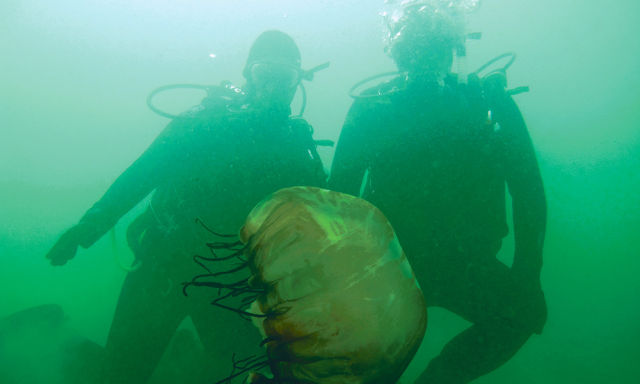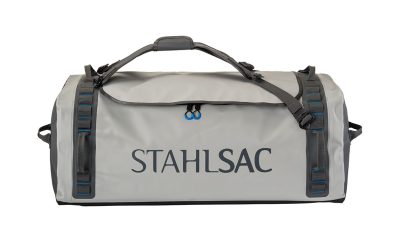Marine Life & Conservation
Scuba Divers In Monterey Dive Against Debris

Earlier this month, Kevin and Melissa Barry were diving near the Monterey breakwater when Melissa found a small, velvet-lined box with an elegant latch. Inside was a plastic bag.
“It was a dog’s ashes,” says Kevin, a San Jose-based scuba instructor.
He was surprised to encounter a pet’s remains, but he had come to expect the unexpected during local dives.
“Of all the places I’ve been, I like Monterey the most,” he says. “Every dive, you see something new.”
Gazing at the shimmering blue waters of Monterey Bay, it’s easy to forget what’s hidden here. But those who plunge beneath the ocean surface know that a box of ashes is only one bizarre example of the human footprint on the seafloor.
Barry’s parents co-own the San Jose dive shop Any Water Sports, and they have long been aware of the underwater pollution problem. As early as 1990, they were organizing “garbage dives” and offering prizes to local divers who collected the most (or the most unusual) trash.
Today, Barry follows his parents’ example by participating in Project AWARE’s ‘Dive Against Debris’ program.
Founded in 2011, ‘Dive Against Debris’ is responsible for the removal of over 400,000 pounds of trash from the world’s oceans.
“Trash in our oceans doesn’t do anything good, and none of it belongs there,” says Ania Budziak, Project AWARE’s associate director. “Scuba divers are equipped with some unique skills. They can breathe underwater and are the only people who can really remove trash.”
Barry leads local Dive Against Debris events annually. The dives tend to draw about 20-30 volunteers with one common goal: to gather as much underwater trash as they can. Afterward, they record when and where each piece was recovered. The data is entered into the Dive Against Debris website, where it falls into the hands of Budziak and her colleagues.
“There are cars, there are shopping carts, there are beds,” says Budziak, recalling some notable items. “I don’t think we really lose this stuff. A lot of it must have been dumped.”
Project AWARE has been gathering debris data for years, but until recently, organizers hadn’t found a good way to summarize and share the data with the locals who gather it. “We didn’t have any way of telling the story of trash comprehensively,” Budziak says.
Now, Project AWARE is compiling the data into the first-ever interactive map of underwater trash. The website, launched April 22, allows divers worldwide to see their uploaded data.
Budziak is optimistic this one-of-a-kind map will help convey where underwater litter is concentrated.
“This is not an effort to scientifically assess how much trash is underwater,” she says. “But it is an attempt to visualize what divers see underwater.”
James Watanabe, a biology lecturer at Stanford’s Hopkins Marine Station in Pacific Grove, sees a bright side.
“The problem of trash in the water depends on the kind of trash,” explains Watanabe, who often leads students in underwater classwork. “Big things with hard surfaces get disguised pretty quickly. Everything here is so prolific in the way it grows. Some pieces of trash become habitats.”
Underwater litter tends to be especially problematic near Monterey Harbor and around Fisherman’s Wharf, he adds. But even there, conditions have been improving.
“It used to be that when we collected octopuses for class, we would dive at the marina and pick up as many beer bottles as we could. Almost every one would have an octopus [inside],” he says. “Now, though, there are fewer bottles.”
Watanabe warns that trash is only a small drop in an ocean of marine conservation issues.
“Trash is the easy stuff, and we need to talk about the hard stuff, the complex stuff,” he says. “But if [picking up trash] changes people’s perspectives on where we are in the biological world, it’s a good thing.”
Changing perspectives is what Dive Against Debris is all about. Budziak says her next step is to survey volunteers to assess whether the project has had any lasting influence on their views or lifestyles.
Barry thinks it probably has.
“It’s kind of a subconscious thing,” he says. “Now, whenever I see a piece of trash, I pick it up.”
Visit www.projectaware.org to join a Dive Against Debris event or check out the new map of underwater trash.
Source: www.montereycountyweekly.com
Blogs
The Ocean Cleanup Breaks 10,000,000 KG Barrier

The Ocean Cleanup, the global non-profit project, has removed a verified all-time total of ten million kilograms (22 million lbs.) of trash from oceans and rivers around the world – approximately the same weight as the Eiffel Tower.
To complete its mission of ridding the oceans of plastic, The Ocean Cleanup uses a dual strategy: cleaning up the Great Pacific Garbage Patch (GPGP) to remove the plastic already afloat in the oceans, while stopping the flow of plastic from the world’s most polluting rivers.
Through cleaning operations in the GPGP and in rivers in eight countries, the cumulative total of trash removed has now surpassed ten million kilograms. This milestone demonstrates the acceleration of The Ocean Cleanup’s impact, while underlining the astonishing scale of the plastic pollution problem and the need for continued support and action.
While encouraging for the mission, this milestone is only a staging point: millions more tons of plastic still pollute our oceans and The Ocean Cleanup intends to continue learning, improving and innovating to solve this global catastrophe.
This announcement comes as governments from around the world meet to continue negotiations to develop a new legally binding instrument to end plastic pollution at INC4 in Ottawa, Canada. Representatives of The Ocean Cleanup will be in attendance and the organization will be urging decision-makers to collaborate towards a comprehensive and ambitious global treaty which addresses plastic at all stages of its life cycle and in all marine environments worldwide, including in areas beyond national jurisdiction.
It is encouraging to see that the need for remediation is reflected in the various options for potential treaty provisions. It is essential that the final treaty contains clear targets for the remediation of legacy plastic pollution, and reduction of riverine plastic emissions.
Tackling plastic pollution requires innovative and impactful solutions. The treaty should therefore incentivize the innovation ecosystem by fostering innovations that make maximal use of data, technology and scientific knowledge – such as those designed and deployed by The Ocean Cleanup.
‘After many tough years of trial and error, it’s amazing to see our work is starting to pay off – and I am proud of the team who has brought us to this point.’ said Boyan Slat, Founder and CEO of The Ocean Cleanup. ‘While we still have a long way to go, our recent successes fill us with renewed confidence that the oceans can be cleaned.’
The Ocean Cleanup was founded in 2013 and captured its first plastic in 2019, with the first confirmed catch in the GPGP coming soon after the deployment of Interceptor 001 in Jakarta, Indonesia. After surpassing one million kilograms of trash removed in early 2022, the non-profit project has since progressed to the third iteration of its GPGP cleaning solution, known as System 03, and a network of Interceptors currently covering rivers in eight countries, with more deployments set for 2024.
About The Ocean Cleanup
The Ocean Cleanup is an international non-profit organization that develops and scales technologies to rid the world’s oceans of plastic. They aim to achieve this goal through a dual strategy: stemming the inflow via rivers and cleaning up the legacy plastic that has already accumulated in the ocean. For the latter, The Ocean Cleanup develops large-scale systems to efficiently concentrate the plastic for periodic removal. This plastic is tracked and traced through DNV’s chain of custody model to certify claims of origin when recycling it into new products. To curb the tide via rivers, The Ocean Cleanup has developed Interceptor™ solutions to halt and extract riverine plastic before it reaches the ocean. Founded in 2013 by Boyan Slat, The Ocean Cleanup now employs a broadly multi-disciplined team of approximately 140. The foundation is headquartered in Rotterdam, the Netherlands.
For more information, visit: theoceancleanup.com and follow @theoceancleanup on social media.
Marine Life & Conservation
Steve Backshall to headline Shark Trust’s flagship event: For the Love of Sharks

Join a host of amazing, shark loving, speakers including Steve Backshall and the Shark Trust team for an evening celebrating shark conservation at the Royal Geographical Society in London this November.
Date: 29th November 2024
Time: 6-10pm
Location: Royal Geographical Society, London
Tickets: https://www.sharktrust.org/Event/flos24
The event will be a celebration of all things shark. Those lucky enough to get hold of tickets will hear from engaging guest speakers with a passion for sharks.
The line-up includes (*subject to change if unforeseen circumstances arise)
Steve Backshall: One of television’s busiest presenters, BAFTA award-winning wildlife expert Steve has been passionate about the wild world ever since he was young.
Steve’s impressive TV career has taken him all around the world, investigating a wide array of species and environments. Steve has filmed over 100 hours of children’s wildlife programmes with the BAFTA award winning Deadly 60 franchise and recently, with Sky Nature, for his new series ‘Whale with Steve Backshall’. He has been a patron for the Shark Trust for 10 years.
Simon Rogerson: is a photojournalist specialising in natural history, diving and the sea.
He is editor of SCUBA magazine, the official journal of the British Sub-Aqua Club. Simon started his career as a crime reporter but gravitated towards his ‘less depressing’ interest in underwater exploration, joining the staff of DIVE magazine in 1999. In 2005 he was named ‘Editor of the Year’ in the PPA’s Independent Publishing Awards. Simon also works as a freelance writer, contributing frequently to the Sunday Times and Telegraph, in addition to BBC Wildlife, Esquire, and a host of international diving magazines. He is the author of a book, Dive Red Sea, published by Ultimate Sports. Now based in Berkshire, Simon has been a Patron of the Shark Trust for 20 years.
More speakers to be announced soon. Head to the Shark Trust website to learn more.
The evening will also allow guests the final chance to see the Oceanic 31, shark art exhibition. Some of the artwork will be auctioned/raffled at the event, while the rest will be auctioned online to raise money for the Shark Trust Oceanic Programme.
For the Love of Sharks is an evening with something for everyone who is interested and fascinated by sharks. Join the Shark Trust, their Patrons, Trustees and Staff, along with a host of supporters for this celebration of shark conservation.
For more information or to buy a ticket: https://www.sharktrust.org/Event/flos24
-

 News3 months ago
News3 months agoCapturing Critters in Lembeh Underwater Photography Workshop 2024: Event Roundup
-

 Marine Life & Conservation Blogs3 months ago
Marine Life & Conservation Blogs3 months agoCreature Feature: Swell Sharks
-

 Blogs2 months ago
Blogs2 months agoMurex Resorts: Passport to Paradise!
-

 Gear Reviews3 weeks ago
Gear Reviews3 weeks agoGEAR REVIEW – Revolutionising Diving Comfort: The Sharkskin T2 Chillproof Suit
-

 Blogs2 months ago
Blogs2 months agoDiver Discovering Whale Skeletons Beneath Ice Judged World’s Best Underwater Photograph
-

 Gear Reviews3 months ago
Gear Reviews3 months agoGear Review: Oceanic+ Dive Housing for iPhone
-

 News2 months ago
News2 months agoPADI Teams Up with Wellness Brand Neuro to Drive Ocean Change and Create a Blue State of Mind
-

 Marine Life & Conservation2 months ago
Marine Life & Conservation2 months agoSave the Manatee Club launches brand new webcams at Silver Springs State Park, Florida

















